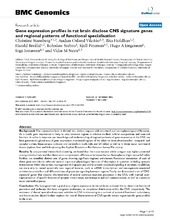| dc.description.abstract | Background: The mammalian brain is divided into distinct regions with structural and neurophysiological differences. As a result, gene expression is likely to vary between regions in relation to their cellular composition and neuronal function. In order to improve our knowledge and understanding of regional patterns of gene expression in the CNS, we have generated a global map of gene expression in selected regions of the adult rat brain (frontomedial-, temporal- and occipital cortex, hippocampus, striatum and cerebellum; both right and left sides) as well as in three major non-neural tissues (spleen, liver and kidney) using the Applied Biosystems Rat Genome Survey Microarray. Results: By unsupervised hierarchical clustering, we found that the transcriptome within a region was highly conserved among individual rats and that there were no systematic differences between the two hemispheres (right versus left side). Further, we identified distinct sets of genes showing significant regional enrichment. Functional annotation of each of these gene sets clearly reflected several important physiological features of the region in question, including synaptic transmission within the cortex, neurogenesis in hippocampus and G-protein-mediated signalling in striatum. In addition, we were able to reveal potentially new regional features, such as mRNA transcription- and neurogenesis-annotated activities in cerebellum and differential use of glutamate signalling between regions. Finally, we determined a set of 'CNSsignature' genes that uncover characteristics of several common neuronal processes in the CNS, with marked overrepresentation of specific features of synaptic transmission, ion transport and cell communication, as well as numerous novel unclassified genes. Conclusion: We have generated a global map of gene expression in the rat brain and used this to determine functional processes and pathways that have a regional preference or ubiquitous distribution within the CNS, respectively. The existence of shared specialised neuronal activities in CNS is interesting in a context of potential functional redundancy, and future studies should further explore the overall characteristics of CNS-specific versus region-specific gene profiles in the brain. | en_US |



